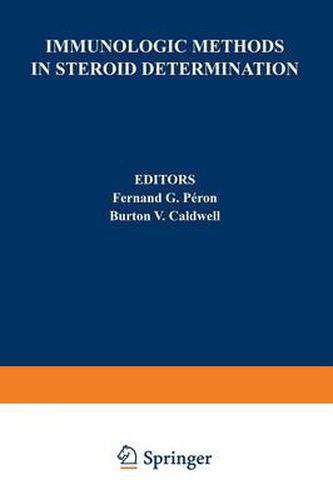Readings Newsletter
Become a Readings Member to make your shopping experience even easier.
Sign in or sign up for free!
You’re not far away from qualifying for FREE standard shipping within Australia
You’ve qualified for FREE standard shipping within Australia
The cart is loading…






This title is printed to order. This book may have been self-published. If so, we cannot guarantee the quality of the content. In the main most books will have gone through the editing process however some may not. We therefore suggest that you be aware of this before ordering this book. If in doubt check either the author or publisher’s details as we are unable to accept any returns unless they are faulty. Please contact us if you have any questions.
The two main goals of the symposium upon which this volume is based were 1) to cement together knowledge presently available in the field of antibodies to steroids and obtainable only under separate covers in different journals and books, and 2) to present new data which could lead to a more complete understanding of physiologic phenomena like those occurring during the menstrual cycle, or to the elucidation of the mechanisms involved in steroid-protection interaction, or to the practical application of immunologic techniques to measurements of steroid hor mones. These techniques are extremely sensitive and can measure levels of steroid on the same order of magnitude as the radioisotope methods. However, the latter are much more laborious and costly which limits their use in many cases to the research laboratory. But the immunologic techniques generally classified as radioimmunoassay, are fraught with difficulties and problems which must be overcome. Fortunately, perhaps, the subject of immunologic techniques as applied to steroid determination is the child of radioimmunoassay of proteins, so to speak. Many of the problems which confront the former have been resolved in the latter instance. Thus, we are in an advantageous position because we are aware of the biologic and technical problems of the earlier radioimmunoassay techniques. Similar experiences have been reported in the book about the use of immunologic techniques for determination of steroid hormones.
$9.00 standard shipping within Australia
FREE standard shipping within Australia for orders over $100.00
Express & International shipping calculated at checkout
This title is printed to order. This book may have been self-published. If so, we cannot guarantee the quality of the content. In the main most books will have gone through the editing process however some may not. We therefore suggest that you be aware of this before ordering this book. If in doubt check either the author or publisher’s details as we are unable to accept any returns unless they are faulty. Please contact us if you have any questions.
The two main goals of the symposium upon which this volume is based were 1) to cement together knowledge presently available in the field of antibodies to steroids and obtainable only under separate covers in different journals and books, and 2) to present new data which could lead to a more complete understanding of physiologic phenomena like those occurring during the menstrual cycle, or to the elucidation of the mechanisms involved in steroid-protection interaction, or to the practical application of immunologic techniques to measurements of steroid hor mones. These techniques are extremely sensitive and can measure levels of steroid on the same order of magnitude as the radioisotope methods. However, the latter are much more laborious and costly which limits their use in many cases to the research laboratory. But the immunologic techniques generally classified as radioimmunoassay, are fraught with difficulties and problems which must be overcome. Fortunately, perhaps, the subject of immunologic techniques as applied to steroid determination is the child of radioimmunoassay of proteins, so to speak. Many of the problems which confront the former have been resolved in the latter instance. Thus, we are in an advantageous position because we are aware of the biologic and technical problems of the earlier radioimmunoassay techniques. Similar experiences have been reported in the book about the use of immunologic techniques for determination of steroid hormones.